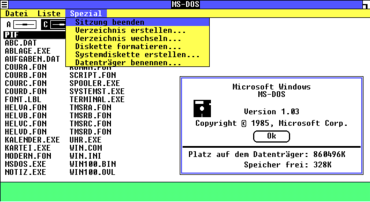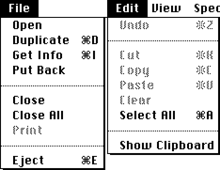Microsoft Windows
![]()
Windows is a redirect to this article. For other meanings, see Windows (disambiguation).
Microsoft Windows (English pronunciation [ˈmaɪ. kɹoʊ.sɒft ˈwɪn.doʊz]) or Windows is originally a graphical user interface developed by Microsoft, which later became a series of stand-alone operating systems.
The original Windows was a graphical extension of the MS-DOS operating system, such as GEM or PC/GEOS. This system was extended starting from Windows 95 by a revised kernel, the 32-Bit-API Win32 and Internet ability and continued with the versions Windows 98, 98 SE as well as ME. For this operating system family the collective name Windows 9x was established. Parallel to this, Windows NT, based on the concepts of the VMS operating system, has been developed since 1988 under the direction of David N. Cutler. Since Windows XP Microsoft sells only successors of Windows NT for the desktop, because Windows 9x was abandoned due to technical weaknesses. Since then, the operating system as a whole is only called Windows (English for "window"). The name comes from the fact that the user interfaces of applications are displayed on the screen as rectangular windows.
Windows operating systems are mainly used on personal computers and servers; in addition, there are variants for devices such as smartphones or PDAs as well as for special embedded devices such as fully electronic measuring devices and retail POS systems or for use in motor vehicles. Kevin Turner, Microsoft's chief operating officer, cited an overall market share of 14 percent for all Windows variants at the 2014 Worldwide Partner Conference. The global market share of the current Windows 10 operating system on all computers was 62.16% in October 2020.
Term
The term Window as a name for a software interface element goes back to the WIMP paradigm (Window, Icon, Menu, Pointing-Device) developed in the early 1970s at Xerox PARC for the construction of user interfaces. Microsoft Windows is a system that implements this paradigm.
Development
Originally, the US company Microsoft did not develop operating systems, but BASIC for various computer platforms since the mid-1970s. It was only with MS-DOS that Microsoft entered the operating system business in 1981, supplying BASICA for PC DOS and GW-BASIC for MS-DOS, among others, and other applications followed.
Microsoft also already contributed a BASIC interpreter for Apple, as well as the application programs Word and Multiplan (later Excel), which were also developed for the Macintosh. Inspired by Apple's graphical operating system, the Macintosh System Software, which in turn was inspired by the computer with the first graphical operating system ever - the Xerox Alto - Microsoft then developed its own DOS-based graphical interface "Interface Manager", which was renamed "Windows" shortly before the release of version 1.0 in 1985.
Already in the run-up Microsoft urged Apple to license the graphical user interface of the Apple Lisa to other PC manufacturers. But Apple did not want to give up its own hardware sales, since about 55% of its revenue came from sales of Apple computers.
When then Apple CEO John Sculley saw Windows 1.0, he immediately wanted to sue Microsoft. But Bill Gates put pressure on Sculley by threatening to immediately discontinue the widely used Macintosh applications Word and Excel unless Apple was willing to make concessions. Although both Apple and Microsoft had licensed the Graphical User Interface (GUI) from Xerox, Windows 1.0 looked all too similar to the Macintosh operating system in some details - right down to the "Special" menu that the Macintosh had first. Since Microsoft had insight into the source code of the "system software" in order to develop application programs, the suspicion of intentional copying was obvious. Microsoft, on the other hand, argued that development of the "Interface Manager" had already begun in 1983 - that is, before the prototype of the Macintosh was available. John Sculley, who was keen to establish third-party applications on the Macintosh platform and therefore did not want to do without Word and Excel, finally settled on a contract on November 22, 1985, which allowed Microsoft to publish Windows 1.0 despite all its similarities to the Macintosh's "system software". When Windows 2.03 was introduced almost three years later, Apple nevertheless decided to sue Microsoft for copyright infringement on March 17, 1988. Over five years later, on August 24, 1993, the suit was dismissed in Microsoft's favor. By then, Microsoft had already achieved a breakthrough with Windows 3.0 and 3.1.

Screenshot of Windows 1.03 (german) with opened menu item "Special

System 1 menus (Macintosh, English): you can see the special menu on the far right (cut off).
Search within the encyclopedia